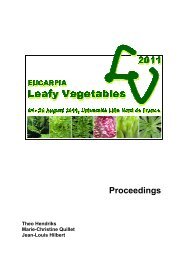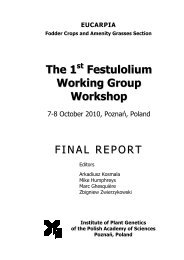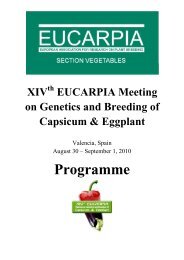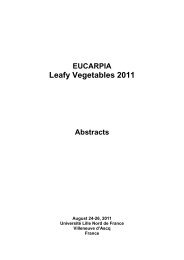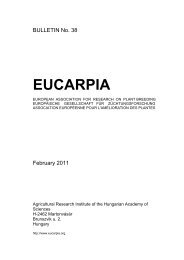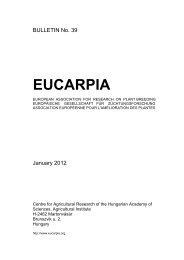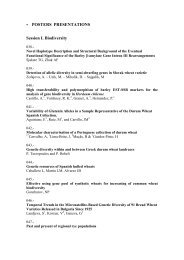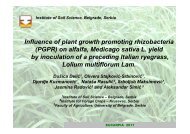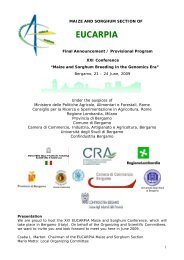Plant breeding for organic and sustainable, low-input agriculture
Plant breeding for organic and sustainable, low-input agriculture
Plant breeding for organic and sustainable, low-input agriculture
You also want an ePaper? Increase the reach of your titles
YUMPU automatically turns print PDFs into web optimized ePapers that Google loves.
Selection of tomato cultivars <strong>for</strong> <strong>organic</strong> production<br />
Ewa Rembiałkowska, Ewelina Hallmann<br />
Warsaw University of Life Sciences – SGGW, Warsaw, Pol<strong>and</strong><br />
The <strong>organic</strong> food products are recognized by the consumers as better <strong>and</strong> safer than conventional<br />
ones. Organically produced plants have often <strong>low</strong>er yields but higher nutritive values that are<br />
very important quality indicators <strong>for</strong> the consumers. There<strong>for</strong>e the aim of the presented work was<br />
to identify <strong>and</strong> to select the best cultivars of tomatoes in terms of their nutritive values. Food<br />
quality can be understood as food safety, measured by the minimal content of harmful substances<br />
(as nitrates, pesticide residues etc.) <strong>and</strong> nutritive quality, measured by the maximal content of<br />
desirable substances (as vitamins, bioactive compounds etc). In the case of tomatoes the most<br />
important is nutritive quality, because these fruits contain only <strong>low</strong> levels of the harmful<br />
substances; the strategy of the plant protects the fruits (<strong>and</strong> seeds inside) against toxins’<br />
accumulation. That is a high advantage <strong>for</strong> the consumers, especially in the <strong>organic</strong> sector.<br />
There<strong>for</strong>e in the presented study it has been decided to focus only on the nutritive values of the<br />
tomato fruits. It’s well known that tomatoes are very good source of the antioxidant compounds<br />
such as carotenoids (lycopene <strong>and</strong> beta-carotene), flavonoids as quercetin, <strong>and</strong> vitamin C.<br />
In the presented experiment nine tomato cultivars have been analysed, in that seven st<strong>and</strong>ard<br />
cultivars: Atol, Awizo, Etna, Gigant, Juhas, Rumba, Kmicic, <strong>and</strong> two cherry cultivars: Piko <strong>and</strong><br />
Koralik. The experiment has been carried out <strong>for</strong> three years in <strong>organic</strong> <strong>and</strong> conventional farms<br />
(two pairs of farms) located in Mazovia region. A lot of quality parameters were investigated to<br />
select the best cultivars <strong>for</strong> <strong>organic</strong> production: the content of dry matter by scale method, total<br />
<strong>and</strong> reducing sugars, total acidity, vitamin C, carotenoids (lycopene <strong>and</strong> beta-carotene) <strong>and</strong><br />
quercetin.<br />
The results obtained indicated that five of nine studied tomato cultivars had much better quality<br />
parameters when plants were cultivated in <strong>organic</strong> way: st<strong>and</strong>ard cultivars Rumba, Gigant, Juhas,<br />
Kmicic, <strong>and</strong> cherry cultivar Koralik. The last cultivar contained the highest level of the most<br />
investigated bioactive compounds. For example Gigant cultivar from <strong>organic</strong> production<br />
contained 8.58 mg flavonols <strong>and</strong> only 5.35 mg per 100 g.f.m. in conventional cultivation, while<br />
the <strong>low</strong>est level of flavonols was found in Awizo cultivar: in <strong>organic</strong> cultivation it was only 1.54<br />
mg per 100 g.f.m, <strong>and</strong> in conventional 1.18 mg per 100 g.f.m. Similarly, the <strong>organic</strong> cultivar<br />
Gigant contained 4.87 mg betacarotene per 100 g.f.m, <strong>and</strong> conventionally cultivated cultivar<br />
Gigant only 0.73 mg per 100 g.f.m. Awizo cultivar contained 1.26 mg betacarotene per 100<br />
g.f.m. when cultivated in <strong>organic</strong> way, <strong>and</strong> in conventional cultivation it contained 1.12 mg<br />
betacarotene per 100 g.f.m.<br />
The above data indicate that some cultivars are able to collect significantly more desirable<br />
compounds when cultivated in <strong>organic</strong> way in comparison to other cultivars. These cultivars can<br />
be really recommended <strong>for</strong> <strong>organic</strong> cultivation.<br />
36




